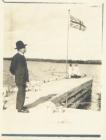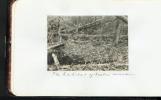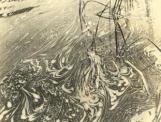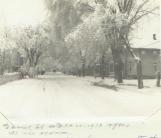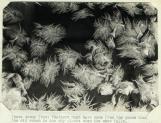48
By 1920, Macnamara's life followed a steady and predictable pattern of working in the office of the McLachlin Brothers Lumber company from Monday to Saturday while spending Sundays in the bush. His interest in pictorialism had diminished with the harsh realities of war. Charles used photography primarily to record his observations of the natural world. There were exceptions such as this photograph where he managed to capture the pensive mood of his father gazing down Chats Lake in contrast to the carefree children playing at the end of the wharf.The Arnprior Chronicle published a tribute to Richard Macnamara following his death in 1921:
A Tribute
Arnprior is indeed the poorer for the death of Richard Macnamara. True his obituary was written two weeks ago, but there are those who think of him each day with affection, in whose memories his smile, his humour, his personality, his very presence remain, as the sweet odor of incense. We who revere his memory and would lay fresh flowers at his bier each day, can realize how he is mourned for in that little family circle-now broken. He was cast in a superior mould; he was given neither riches, rank nor unusual education, but greater than all of these was a master intellect that made all things possible, except rank, and that he did not desire. He was a profound reader and a greater thinker, thus he was broadminded; he was a native of northern Ireland, yet he strongly advocated Home Rule; he was an ardent Presbyterian, he was consistent about it and he liked others to be consistent no matter what their religious belief might be; he was charitable to an unusual degree, in fact he gave largely of his means in this way, always quietly, always without ostentation; he possessed the humor characteristic of his race and the word "pessimism" was not included in his vocabulary. He sought not earthly glory, he harbored no illwill against any man, he loved God's sunshine, flowers, trees and little children; he loved all that was honorable, beautiful and chivalrous; his friends were legion and he had no enemies - such types of men are not usual in this day; such a man was Richard Macnamara.
50
Charles Macnamara often wrote in notebooks and journals about his Sunday walk in the bush to his cabin at Marshall's Bay. One small, black leather journal is filled with his thoughts, photographs and observations from A Walk on the 4th of October 1925.Wrapped in waxed paper, four sandwiches of cheese, lettuce and onion - a fine relishable combination - are awaiting me on the sideboard, along with the Thermos bottle of coffee, and my own particular white enamel mug. I pack a peach into the mug as a safe place where it won't get squashed, and add to the lunch three soft ginger cookies with raisons in them, which as made by Maggie are the best of all known cakes. This lunch is stored away in a game bag along with a small sieve to sift the forest litter for insects, and the Times Literary Supplement to read while I eat the lunch, or sit down to rest. Of course, my pockets are full of all kinds of things too: camera, field glasses, two cases of collecting vials, no less than three magnifying glasses, two rolls of spare film, a supplementary lens, a note book, match box, two pocket knives, and several minor etceteras. My coat is simply not a coat; it is a traveling bag, and weighs about as much.
Thoreau says beware of any enterprise that calls for new clothes, and not rather a new man in old clothes. I don't know that there was anything particularly new about the man, but the clothes were old. And as suitable clothing is very important on an expedition like this, I think that what I wore deserves to be described just as much as the dress of a lady at a ball or wedding or other trivial occasion. The hero, then, was costumed in black laced boots, Blucher cut, with Phillips soles. He thought they were waterproof, found out later in the day that they were not. His socks were ribbed wool of an aesthetic blue grey color. Above this he was mostly covered with a "complet" of Harris tweed of the same shade as the socks - a trifling but vital harmony - the material being woven in the design which my friend Pat Galvin, calls "hurrin bone effect". The suit, cut to an easy lounge pattern, showed some signs of wear as Harris tweed always should. A blue-striped shirt and white collar with a black poplin tie, and a cap of the same cloth as the suit, completed a quiet but recherche ensemble. I sling on my game bag, and Marian just came down for breakfast, tells me to be careful of my knee. And to paraphrase Sam Wheeler at the celebrated trial of Bardell vs. Pickwick, I was very careful of that 'ere knee, very careful indeed my lord". Then I go off alone. And rightly alone; I am no fit company for anyone. For I whistle "Sweet Genevieve", "Marching through Georgia", "Old Black Joe", "When You and I Were Young" and other gems from the classics. Then I sing a little: "The Two Grenadiers", "The Heart Bowed Down" and "Mary of Argyle". I would sing "Le Cor" if I could. I like it very much, but I remember only the words and not the air. This starts me off on an even worse course. I recite "Le Cor" aloud; then Lotus Eaters, my best loved poem in all literature; then pieces out of Swinburne, and some of Heine's songs. It gives me a lot of pleasure to repeat poetry like this, but I simply hate to hear other people doing it.
The leaves are just beginning to change color. The green is fading to yellow, and a maple here and there is turning to scarlet. In one field a bank of sumack is a dull crimson. There is scarcely an air moving down here, but in the sky, fleets of small white clouds are sailing up from the west. I follow the road that skirts along Mackies' Bush and leads to the Brown farm. Unpicturesque designative names, if they survive long enough for their homely meanings to be obscured by time, they too may sound as romantic as Irmuz or Vallombrosa.
It is two long months since I have been here, and there are a lot of familiar places to inspect. First the porcupine den in a crevice in the rocks. As usual, there is a porcupine at home. It is too dark in there to see him but I hear his quills rustling as disturbed by my presence, he squeezes a little farther into the fissure. From scatological evidence at the threshold, it is plain that this has been the old porcupine homestead for many a year.
Then I climb over fallen trees and mouldering logs, being very careful of my knee, as my kind sister enjoined, and came to a green mossy place, where three years ago at this season, I found a rare springtail, Neelus minutus Folsom, which was only the second time it had been discovered anywhere in the world. All springtails are small, but this one, even under a magnifying glass, is only a moving speck. Sifting of dead leaves and moss, kept up for over an hour, yielded six or eight species of Springtails, but no Neelus. They will be for another time. Sifting is fascinating work. All kinds of queer little Arthropods and other humble creatures come tumbling down onto the hankercheif spread on my knees. Here if ever the unexpected happens, and curious forms of life I never saw before often appear.
But this time, I am looking for Neelus, and as they are not to found, I pack up and leave this lowland by a rough road the log cutters made last fall. It is the simplest possible expression of a road, and scarcely disturbs the forest life. Next spring, hepaticas and pepper-root will grow in it as usual, and in a few years the trees will have stepped into it, and it will be gone.
I come out on the lower field of the Brown Farm, a square field shut in by four square walls of trees like a very large courtyard. The original Mr. Brown, whoever he was, cannot have gained more than a scanty living from his farm. The cleared acres are few, and the soil is sandy. Leased now-a-days by McLachlin Brothers Limited as a pasture for shanty horses. One of the farms chief crops is golden rod. Its yellow opulence has vanished now, and it shows only an indeterminate grey and brown. The only semblance of a blossom left anywhere is the pearly everlasting, and this is really gone to seed and dead too. It is only the dried mummy of a flower.
I go down the little dip through the fringe of trees that divide one field from the other. A little stream runs here in the spring and in the sand I find the diatom heridian. "My walks are in the fields I know" for so many years that every yard of the way has its associations and memories. Across another tree-enclosed field to the old log fence which marks the boundary between the Counties of Renfrew and Carleton. The fence is thrown down, but most of the cedar logs are lying there yet, such cedars as cannot be found in the country now. Then across the bed of another little stream, dry now but a busy enough brook in the spring, and I am in the field where the Black-eyed Susans bloom in July. But neither can these beauties keep their lustrous eyes and only withered stocks remain.
Now I am coming to the grove of little maples and ironwoods. Where the grouse burrow in the deep snow in cold weather, and where on the rocks the spring beauties grow the thickest in May. Through the wire fence into the wood of large maples where I think of trying in the dead leaves for more Springtails. Here last spring I found Paranura colca Folsom, a sluggish white insect without eyes, whose most characteristic mark as a springtail is a large sickle-shaped sense hair on the antenna. But the ground is far too dry. There is no hope here of springtails, to whom moisture is an absolute essential of life. So out of the wood and into the sunlight to sit on a log and read a fine article in the Times Literary Supplement on Swifts Journal to Stella. I think I shall have to buy that book.
There are not many birds about today. A few chickadees busy in the trees remind me of winter. A short time ago I saw in a bush pile two little winter wrens, finest of all our bird singers, but of course, silent now. A hawk screams in the tree tops away down towards the lake; and a robin, his autumn shyness on him, flies startled away with a quick alarm note. A few grasshoppers and crickets are stirring dully in the grass, which is still green and soft. The sun has warmed them up for a little while, but their time is short.
It is now getting on to one o'clock and time for lunch, so I go through grass where the wild roses are thick in early summer, and down the dampish road that in the season is bordered with closed gentian, and I come out on the sandy shore of Goodwin's Bay, where the snapping turtles lay their eggs in June. A road is being sketched out by Jerry Hayes and his boom-men to enable Dan McLachlin to reach his camp by motor car. The only way to get to it at present is over a very occidented footpath or by water. They are building a bridge of boom sticks over Elliott's creek, and here I see two fox sparrows at the edge of the water. Their bright brown tails are noticeable. I sit on a log to eat lunch, a log so old that the lumbermen have lost all interest in it, and leave it lying here on the shore. The lake is glassy except for a minute, and then dies away again. A little to my left are the three pines through which you get the best view of Goodwin's Bay. Like the Three Musketeers, there are really four, but one is a cedar.
I indulge my inveterate habit of reading at meals by finishing the article on Swift's Journal while at lunch. And with my field glasses, I observe motor boats away over at the Quebec shore. Three young men, dressed in their Sunday clothes, come down the road behind me and pass on the new bridge. They look like mill men. I do not know them, but they probably know me. Mark these last two sentences, for here I am adopting a Victor Hugonian device of casually mentioning some apparently trivial but actually portentous event.
Lunch finished, I go back up the dampish road a few yards to the mouldering log that our snowshoe trail steers by at this point on its way to Marshall's Bay in the winter. The only sign of the trail now is a faint path through underbrush which I follow to the beaver meadow.
The motif here is bright green: sopping wet green underfoot and the trees and bushes still green around. There is no sign of autumn change here yet. There used to be a squidgy path along the meadow next to the rocky edge of the higher wooded ground. It was just possible for an animal not quite an amphibian. It is not so now. The beavers have raised the water so that the only dry-shod, or rather damp-shod, way is to climb laboriously over and under and through a tangle of fallen trees and underbrush. I think the beavers might have some consideration for me, their friend and not drive me into an abbattis much like that which caused the defeat of the English at Ticonderoga. However, there are no French soldiers poking triangular bayonets through the logs at me, or firing round musket balls, and so I do make some progress. If I complained to the beavers about this, they would likely say, "Who are you, and how long have you and your likes been in this country to make you think you own it? Come back after you have been here fifty or a hundred years, as we have been, and then we will talk to you". Well, perhaps I had better wait awhile before I say anything.
I come to where the old punt is chained to a tree. Someone uses it to spear fish from in the spring. It is resting in the grass now, and its chain looks unnecessary. A little way above the boat is the "Flat Rock Dam". I used to sit on the rock and eat my lunch, reading a French play the while. It was a smooth sloping rock at the edge of the creek, and the only solid dry place in a large expanse of swamp. One end of the dam rested on it, but the dam is growing and has passed it now towards the higher ground. I will eat my lunch no more on the Flat Rock. The water is slowly creeping over it, and the way out to it is along a soft mud bank, the preliminary extension of the dam, not well reinforced yet not consolidated. I stand on the bank to photograph it and sink into the mud. The water begins to run into my boots, and the exposure is made in such a hurry that I forget to wind the film - as turns out later.
I decided that with my doubtful knee, this is walk enough for today; and so pick my way back in another direction. And a very wet way it has become, with familiar paths and runways flooded by the heightened dam. Up a little level densely wooded valley through which I often showshoe in the winter. It is dark here with balsam, spruce and cedars, and well sheltered from cold winds. My winter road is marked with a few blazes on the trees, and I follow it until I come to a faint side trail up the smooth rocks, known only to me and a porcupine. Over the rocks through small trees and between sumach bushes to a little clearance on the hillside, closed off from the fields by a screen of trees. I sometimes sit and read in this private place, and see people passing in the fields who do not see me. Here I finish the last of my lunch, and also the article on Swift's Journal.
As I get up to leave I find my field glasses are not in my pocket. Left on the log where I ate my lunch, or dropped when clambering along the edge of the beaver meadow? The log is not much out of my way going home and I swing my track to it. There are no field glasses there. I make an exposure on the glassless log, and as I discovered in the dark room that night, it goes onto the same film as the beaver's mud bank. If the glasses are lost in the beaver meadow, they are gone for ever. If I left them on the log, perhaps the young men who passed me when I was at lunch came back this way and picked them up. If they are honest, I get the glasses back. If not, I won't.
Homeward through familiar fields, repeating "Ulalume". It is not night yet, and only a few leaves are crisped and sere, but it is October, and the poem is that far appropriate. The large elm is a fine land-mark. No matter what route I am following, someway I always have to pass close to it. It makes me feel small but gives me a sense of protection. In the same field, on the north side, a maple has changed to a vivid and beautiful color, hard to describe, a kind of lovely rose-pin. Of course, I have to photograph it. And, as usual, the print is a blank disappointment. The difference between the cold monochrome of the picture and the glowing color of the tree is the difference between the real and the ideal.
So home through Mackie's Bush, the winding road between the tall trees; over the heavy log fences into the precincts of the lumber yard. The logs are held between the stakes by wires, which must be slowly rusting, and some day one of the top logs is going to fall. I hope I won't be climbing over it at the time. Across the smooth glaciated rocks, the ball room floor prepared by the ancient ice sheet. I always stop to look at the curious markings, planed down sections of mysterious concretions. I go home by a track through the lumber yard so as to avoid the dust of automobiles on the road. In the morning when I am going out there are not many cars passing, but at this time of day they are thick.
At seven o'clock in the evening two young men come to the door with my field glasses. They had found them on the log. One of them, who handed back the glasses, was Anthony Dechene, who with some young friends entered my cabin at Marshall's Bay a few years ago. But they did not do much harm, and the boy acted honestly on this occasion.
Charles Macnamara
52
Charles Macnamara had an endless curiosity to learn as much as he could about the natural world around him by making careful observations, sometimes over long periods of time and documenting his discoveries. He often corresponded with experts in the field who invariably replied that the photographs which he sent were of excellent quality and could he possibly send more.He took correspondence courses in Entomology, taught himself German and French and even took a memory course at the age of 49. He was Treasurer of the Red Cross society during the first world war and selected books for the Arnprior Public Library.
Not only did he look after the accounts of the McLachlin Bros. Ltd company, Charles also took care of the personal accounts of various members of the McLachlin family.
54
Even patterns in a stream caught Macnamara's attention. He recalled in an essay on The Relativity of Motion that "When I was a boy I often leaned over the old Mill Bridge across the Madawaska at Arnprior and watched the water rushing down the log slide below me. When I looked steadily at the water of a minute or so, a strange thing would happen. The water suddenly stood still and the bridge began to race backwards upstream. The illusion lasted for perhaps a minute, then the bridge stood still again and again the water went foaming and swirling down the slide".56
When Arnprior was hit with a serious ice storm in December of 1939, Macnamara recorded the effects of the storm on the trees along Daniel and Madawaska streets. He also photographed scenes of trees weighted down with ice and snow in the bush around Marshall's Bay while conducting the Christmas Bird Census. He wrote the following in his scrapbook of observations called Personals & Sundries:"The ice storm of 19 December 1939 which swept the Ottawa Valley from Campbell's Bay almost to Montreal, heavily coated trees with ice and snow. Thousands of them broke down with the load. Strange to say, the evergreens, pines, spruces, balsams, hemlocks, whose dense branches must have caught a maximum quantity of the sleet, suffered less than the bare deciduous trees. Poplars were the worst hit, then the white birches. Many elms lost large branches, yet the conifers soon shed their ice load, and ten days or so after the storm were perfectly recovered."
Sixty years later the Arnprior area was hit with another ice storm which damaged trees and caused lengthy power outages.
58
"Young Beeches do not readily shed their leaves in the fall; many remain on the tree all winter and by spring they are washed and bleached to pallid phantoms, wan ghosts of the fresh green leaves of last summer".60
"These downy frost feathers must have come from the goose that the old woman in the sky plucks when the snow falls."Charles Macnamara experimented with Gamma and red "A" screens to best capture frost on the window pane. In order to get contrast in the design, a dark background was necessary. At some windows he could use an adjacent building but he sometimes hung a black cloth from the roof outside the window. Macnamara disagreed with Seumas O'Sullivan who wrote that frost flowers were ghosts of flowers that died. He liked to think that the frost flowers were "flowers in their own right, flowers of winter scarcely less marvellous than the flowers of summer". He kept meticulous notes about which window he had photographed each pattern and what temperature created it.
"Why the back window should have two such distinct patterns as the 'seaweed' and the 'palm leaf' puzzled me for a while. Then I noticed that when the moisture on the pane began to freeze as the outside temperature gradually fell from 32 degrees Fahrenheit or higher, the 'palm leaf' was always produced."
Charles Macnamara
28 April 1940
